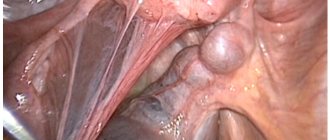Fraxiparine injections into the abdomen for pregnant women
The administration of Fraxiparine solution in pregnant women is justified when coagulation system disorders are detected. When carrying a child, the risk of blood clots in the expectant mother is due to the growth of the placenta, the layers of which are rich in blood vessels. In the presence of predisposing factors, the likelihood of thrombosis increases, leading to blood stagnation and fetal nutritional disorders.
A deficiency of oxygen and other nutrients causes irreversible damage to the fetal body systems at the cellular level, therefore, to eliminate the threat to the health of a pregnant woman, as well as for the normal development of the fetus, it is advisable to use the glycosaminoglycan heparin.
Mechanism of action of the drug
Fraxiparin solution for subcutaneous administration is a low-molecular-weight heparin (depolymerized elements of heparin glycosaminoglycan), which has a pronounced antithrombotic effect. The drug activates blood clotting factors, has an antiplatelet effect, and stimulates activated partial thromboplastin time to a lesser extent.
Analogues of Clexane during pregnancy
In addition to Clexane, there are many antithrombotic drugs that are also actively used depending on the circumstances - in the postoperative period and at other times, but not all of these drugs can be used during pregnancy.
Complete analogues of clexane are:
- Novoparin;
- Warfarin;
- Hemapaxan;
- Wessel Due F.;
- Anfiber;
- Enoxarin;
- Fragmin;
- Angioflux;
- Fraxiparine.
Analogs of Clexane differ in composition, mass of substance, and release form. All of them have different effects on the body of a pregnant woman. Therefore, you should never prescribe such medications yourself. Only a doctor can combine all your tests, which contain a great many different nuances, indicators, numbers, and prescribe you exactly that drug, and not that one.
The prescription of Fraxiparine is quite common and many are interested in which is better - Clexane or Fraxiparine during pregnancy. We certainly cannot answer this question in any way, the compositions are very similar, but for some pregnant women Fraxiparine is not suitable or, on the contrary, Clexane. And the most important thing is that the gynecologist, as a rule, consults with a hematologist (in any case, he should do this) and if the necessary tests are available, only they decide which drug to prescribe and in what dose.
This drug has many effective analogues in composition. These include Novoparin, Enoxaparin sodium, Anfibra, Enoxarin, Hemapaxan. The medications have similar side effects and are safe for health in recommended doses. You can also purchase medications with a similar effect at the pharmacy, such as Fragmin, Angioflux, Fraxiparine, Wessel Due F. The solution in disposable syringes is sold in pharmacies at 02 mg; 0.4 mg; 0.6 mg or 0.8 mg. The duration of treatment can vary from 2 to 10 days.
In the early stages, the drug is not prescribed. In the later stages of pregnancy, the doctor will refer you for an examination and then decide on the duration of treatment. There are contraindications to injections that should be taken into account when making a diagnosis:
- hypersensitivity to active components;
- tendency to bleed;
- ulcerative lesions of the gastrointestinal tract;
- malignant neoplasms;
- recent operations;
- arteriovenous malformations;
- damage to the walls of blood vessels and their expansion;
- preliminary anesthesia using enoxaparin sodium;
- antiplatelet antibodies in the blood;
- age up to 18 years.
During pregnancy, you should take the medicine with caution if the pregnant woman has uncontrolled arterial hypertension, bacterial endocarditis, retinopathy, large open wounds, or insufficient renal or liver function.
When planning a pregnancy, you need to monitor your health. If there are hemostasis diseases, it is better to consult a therapist or gynecologist and undergo a course of treatment in advance. Self-treatment increases the risk of premature birth.
List of indications and contraindications
Fraxiparine injections into the abdomen to thin the blood are used to prevent and treat increased blood clotting or already formed thromboembolic disease. In addition to use during pregnancy, the drug is used for the treatment of deep vein thrombosis, as well as for creating artificial hemophilia during artificial circulation.
The main contraindications for the administration of Fraxiparine are:
- individual intolerance to components;
- acute bacterial inflammation of the inner lining of the heart;
- inflammation of the serous membrane of the heart (pericarditis);
- thrombocytopenia with a positive in vitro aggregation test with the addition of the drug;
- hemorrhoidal stroke;
- immunopathological inflammation of blood vessels;
- central serous chorioretinopathy;
- hypertension and postural hypotension.
Fraxiparine is prescribed with caution to patients with bleeding, central nervous system injuries, severe liver or kidney failure, diabetes mellitus, and exacerbation of gastric ulcers.
Reasons for therapy during pregnancy, after IVF
The administration of Fraxiparine to pregnant women is recommended to prevent thrombosis in the following cases:
- there has been venous thrombosis in the past (single with risk factors or repeated);
- there is a hereditary tendency to thrombus formation (blood relatives had vascular diseases - thrombophlebitis, pulmonary thromboembolism, blockage of the deep veins of the leg, stroke, heart attack);
- Blood tests revealed increased coagulability, antibodies to phospholipids, and gene mutations that impair the formation of anticoagulant factors.
Deep vein thrombosis of the lower extremities
Increased blood clotting is often the cause of unsuccessful in vitro fertilization. Hormonal preparation for IVF also aggravates the tendency to blood clots. Due to impaired blood flow in the uterine wall, it is difficult for the fertilized egg to attach, nourish the embryo, and form the placenta. This leads to early miscarriages.
To prevent embryo rejection and complications such as vein blockage, Fraxiparine is administered during the preparation period for pregnancy. This increases the chances of conception by almost 25%. After its onset in the first trimester, the drug is most often discontinued, and from the end of 3 months until the very birth, the woman is prescribed prophylactic doses of the medication.
Watch this video about when low molecular weight heparin is prescribed during pregnancy:
Dosage and recommended course of administration of the drug
Fraxiparine is available in syringes pre-filled with a solution for subcutaneous administration, 10 pieces per package. A single dose varies from 0.3 to 1 ml. Before treatment, the number of platelets in the blood is determined, then their level is monitored 2 times a week during therapy.
To prevent thromboembolism during pregnancy, a minimum dose of the drug is prescribed: 0.3 ml once a day.
Before operations, the drug is administered once a few hours before surgery. The course of injections is continued for a week after surgery until the patient fully recovers.
Fraxiparine effectively replaces traditional therapy for thrombosis with heparin. The drug is administered at intervals of 12 hours for 10 days. The dose of the drug depends on the patient’s weight.
I want a baby!
I bought fragmin, which comes directly in a syringe with a needle
comes in the package. The needle there was very thin and small, no more than 2 cm, so it was not so scary and difficult. Those. specialist. hypodermic needle. The injection was made at the level of the navel at a distance of about 2-4 cm from it, alternately on the right and then on the left. The syringe was held slightly at an angle. If you tilt it too much, the medicine was injected very directly under the skin and a small swelling appeared, which quickly went away. After 1-2 injections you can easily get used to it yourself, it’s not painful and not scary!
Ollie 01/13/2009 at 00:00:21
Subcutaneously, pricked in the forearm (-)
I inject Clexane and am crazy about the prices today:-(((
I bought it at a pharmacy store in Bessarabka. Once upon a time, a syringe of Clexane 0.2 (minimum dose) cost 25 hryvnia, but now it costs 67.5 hryvnia. I'm shocked. Because if I get pregnant (currently I only inject for 12 days in a cycle), I have to inject it ENTIRE pregnancy plus 2 weeks after giving birth. What a sum it adds up!
price for fragmin
also changes every time, I buy 10 pieces and every time it’s cheaper, sometimes more expensive
How much does a 0.2 or 0.3 syringe cost on average?
They just prescribed Clexane to me because it is the newest and the only one that lasts 24 hours. The same fraxiparine and fragmin - 18 hours each.
And in general, you shouldn’t inject anything in the forearm, or anywhere except the fold near the stomach. This is what I am telling you EXACTLY.
the first time for 640 (10 pieces), the second time 420, and the third time - 550 UAH.
The drug Fraxiparine based on nadroparin calcium is intended to thin the blood and prevent the formation of blood clots. The drug has an impressive list of contraindications and side effects, so Fraxiparine injections into the stomach during pregnancy are prescribed no earlier than the second semester if there is an urgent need to prevent thromboembolism or treat already formed venous thrombosis.
Rules for insertion technique
To achieve the desired results, it is important to correctly inject Fraxiparine into the stomach during pregnancy. When determining the injection site, avoid the navel area, as well as the midline of the torso; the optimal area is the lateral abdominal wall. To avoid the formation of lumps or lumps, it is not recommended to administer the drug if there is swelling, scars, bruises on the abdomen, damage to the integrity of the skin, dermatological or allergic diseases.
Injections are made into the subcutaneous tissue to a depth of about 15 mm, after pre-treating the skin with an antiseptic. Using the index finger and thumb of your left hand, grab an area of abdominal skin to form a fold. With the right hand, take the syringe with the medicine, place the needle with the cut up at an angle of 45 degrees to its base of the fold and slowly inject the drug. A swab with a disinfectant solution is pressed to the injection site and the needle is removed.
Compatibility, analogues and cost
Fragmin injection solution can be mixed with glucose (a 5 percent solution is suitable), as well as with sodium chloride (9 percent solution).
At the same time, the combined use of an anticoagulant with antihistamines (antiallergic) drugs, tetracycline antibiotics, glycosides and ascorbic acid can lead to a decrease in the activity of its main active component.
with acetylsalicylic acid can have the same effect , although in this case the risks of decreased blood flow in the kidneys with their subsequent excretion sharply increase.
other anticoagulants in one therapeutic regimen , as well as non-steroidal anti-inflammatory drugs, vitamin K inhibitors, thrombolytics and platelet inhibitors in order to avoid the development of severe internal and external bleeding.
In any case, the treatment complex should be developed by a qualified specialist, taking into account all these and many other important features of the anticoagulant.
As for the most common analogues of Fragmin, today this list includes such drugs as injection solutions Fraxiparine, Clexane and Anfibra , as well as Angioflux and Vessel Due F
Currently, several pharmaceutical companies in the Russian Federation produce Fragmin. The price in Moscow ranges from 1950 to 2970 Russian rubles, depending on the dosage, release form and the number of ampoules/syringes in the package.
Pharmacies are not allowed to sell this medicine without a doctor’s prescription, otherwise the risk of self-medication and the development of serious complications increases.
Possibility of side effects
The use of nadroparin calcium can cause the formation of hemorrhages and the development of allergic reactions. Sometimes there is a decrease in the number of platelets in the blood. Hematomas and necrosis of the skin at the injection site may occur in the area where the drug is administered. An overdose of the drug is manifested by increased bleeding.
If undesirable symptoms appear, you must immediately stop taking the drug. To neutralize the active substance Fraxiparine, an antidote is administered - protamine sulfate or hydrochloride.
When a specialist prescribes Fraxiparine to an expectant mother during pregnancy, she often begins to worry. Many women are sure that various medications can greatly harm their baby. However, if there is a risk to the mother's life, the drug is still prescribed. But treatment must be carried out under the supervision of a doctor.
There are several cases when doctors prescribe Fraxiparine when planning and managing pregnancy. These include:
- prevention of hypercoagulation;
- increased blood clotting, causing thrombus formation;
- prevention of thrombus formation in case of surgical operations;
- prevention of thromboembolic complications with a high risk of thrombus formation;
- treatment of myocardial infarction;
- treatment of unstable angina;
- treatment of thromboembolism.
Some expectant mothers have to take the drug in all trimesters. Not all experts believe that this medicine is absolutely safe. Doctors are confident that during the first trimester the product should not be used for prevention and treatment. During pregnancy at a later stage, the doctor should make a decision on prescribing and discontinuing fraxiparine only after test results. Let's find out more about this drug.
Pharmacodynamics and pharmacokinetics
Pharmacodynamics
Low molecular weight heparin produced by depolymerization from standard heparin; chemically it is a glycosaminoglycan with a molecular weight on average of 4300 daltons.
It has a high affinity for the blood protein antithrombin 3, which leads to the suppression of factor Xa - this is mainly due to the pronounced antithrombotic effect of nadroparin.
Activates: tissue factor transformation blocker, fibrinolysis by direct release of the tissue plasminogen stimulator from endothelial tissues, changes in blood rheological parameters (decreasing blood viscosity and increasing the permeability of the membranes of platelet cells and granulocyte cells).
Compared to unfractionated heparin, it has a weaker effect on platelet activity, aggregation and primary hemostasis.
During the treatment period, at maximum activity, the aPTT may be prolonged by 1.4 times more than the standard one. In prophylactic dosages it does not cause a strong decrease in aPTT.
Pharmacokinetics
After subcutaneous injection, the highest anti-Xa activity, that is, the maximum concentration in the blood is achieved after 4-5 hours, is almost completely absorbed (up to 88%). With intravenous injection, the greatest anti-Xa activity occurs after 10 minutes. The half-life is approximately 2 hours. However, anti-Xa properties appear for at least 18 hours. Metabolized in the liver by desulfation and depolymerization.
When can you use the product?
Despite reviews from some doctors that Fraxiparin is safe during pregnancy, you should not use it unless absolutely necessary. A specialist usually prescribes the drug to a patient if the threat to the mother’s life is higher than the potential risk to the fetus.
Therapy during pregnancy
The drug is prescribed as a prevention and treatment of pathologies that provoke increased blood clotting. The doctor individually determines the duration of taking the medicine. The duration of the course directly depends on the severity of the sore.
Sometimes expectant mothers are forced to inject the drug during the entire period of pregnancy. The drug has a specific mechanism of action, which does not depend on whether it is prescribed for planning or managing pregnancy:
- the drug binds to blood plasma protein, suppresses blood clotting factors;
- reduces blood viscosity;
- prevents blood platelets from sticking together.
There is still heated debate about how dangerous fraxiparine during pregnancy can be for the fetus and the expectant mother. Some experts believe that the medicine is not capable of negatively affecting the fetus, and long-term practice of use confirms this.
Others believe that the medicine can cause severe internal bleeding, which is very dangerous for the health of the woman and her baby. In addition, the instructions indicate that scientists have not conducted any studies on the effect of the drug on the fetus, so it cannot be said that it is completely safe.
During pregnancy, the doctor prescribes fraxiparine injections only in critical situations when increased blood clotting is observed. This condition can cause:
- premature labor;
- intrauterine death of a baby;
- spontaneous termination of pregnancy.
Doctors usually prescribe the drug only in the second or third trimesters. There are several reasons for this.
The placenta grows with the fetus throughout the entire nine months. It develops a network of capillaries and blood vessels that provide nutrition to the baby. If a woman’s blood thickens, it begins to stagnate in the capillaries. As a result, blood clots and oxygen starvation of the fetus appear. This cannot but affect his development and well-being.
During the last trimester, the uterus reaches its maximum size, so it puts a lot of pressure on the veins of the small pelvis, which causes a deterioration in blood flow in the legs. Blood begins to stagnate in the lower extremities, so blood clots may appear. The result is pulmonary embolism. This threatens the death of the woman and her baby.
Prescribed for planning and managing pregnancy
But in any case, during pregnancy, the drug tranexam, fraxiparin and other drugs should be prescribed only by a doctor after an individual consultation. Sometimes the remedy can save the life of a woman and her fetus. Therefore, it cannot be said that the medicine is strictly prohibited. Everything must be decided on a personal basis.
| Advantages | Flaws |
| Less risk of developing renal osteodystrophy. | Dangerous during the first trimester. |
| Positive effect on lipid metabolism. | Causes many side effects. |
| Possibility of therapy on an outpatient basis. | High price. |
Side effects and contraindications
During pregnancy, you should carefully read the instructions for use of the drug Fraxiparin. Like almost any potent, effective drug, Fraxiparin has its own contraindications and side effects. Therefore, before using the product, you need to carefully study the problem and take into account the possible risks that may arise from the treatment. The medicine is prohibited in the following cases.
- The patient cannot tolerate the active substance nadroparin, which is present in the drug.
- Coagulopathy, which is a deficiency of blood clotting, is observed.
- There was no result from therapy with antiplatelet drugs: Aspecard, Cardiomagnyl, Aspirin Cardio.
- Acute infective endocarditis.
- Hemorrhagic cerebrovascular injury.
- Development of thrombocytopenia after previous use of nadroparin calcium.
Side effects may develop after treatment, however, judging by the doctor’s feedback, they are rare. Refers to negative reactions.
- Anaphylactic shock.
- Quincke's edema.
- Hives.
- Allergies in the form of itching or rash.
The drug should be taken with caution by women who suffer from complications in the gastrointestinal tract, high blood pressure, circulatory problems in the eye area, kidney or liver problems. Please note that an overdose may cause bleeding. The level of liver enzymes (AST, ALT) may also increase.
How to inject medicine correctly
Before a doctor prescribes fraxiparin injections into the abdomen during pregnancy, he must send the patient for a blood test to determine the blood clotting index. The dosage of the drug is prescribed on a personal basis only after tests show the need for treatment. Duration and dose depend on body weight and degree of disease.
It is very important to know how to inject Fraxiparine during pregnancy. It is intended for subcutaneous and internal administration and is available ready-made in a syringe. Available in two volumes: 0.3 ml and 0.6 ml.
During pregnancy, it is best not to watch a video about how to properly inject yourself with fraxiparine, but to entrust this matter to specialists. Injections should be given once a day. But not everyone has the opportunity to go to the clinic every day, so some patients prefer to carry out the procedure themselves at home.
- You need to take the syringe so that its needle is pointing upward, and then slowly squeeze out all the air.
- Measure a distance of two fingers from the navel upward (there are no blood vessels here).
- Wipe the skin with a disinfectant solution.
- Take the skin so that a vertical fold is formed.
- Insert the needle into the skin at a 90 degree angle.
- Slowly inject the medicine.
- Pull out the needle and press the cotton wool to the injection site.
Contraindications and unwanted reactions of the body to it
Fraxiparine is an effective remedy with a strong effect. That is why it has a whole list of side effects and contraindications for use.
The doctor must study the situation very carefully and analyze the risks of taking it.
The drug should not be used for allergies, blood clotting deficiency, or in the absence of results from treatment with antiplatelet drugs.
As for side effects, the use of the drug is likely to cause rash, itching, urticaria, Quincke's edema and anaphylactic shock. It should be used with extreme caution in the presence of impaired liver function.
This also applies to poor kidney function, impaired blood circulation in the eyeballs, high blood pressure, and complications in the digestive tract.
In case of overdose, the risk of bleeding increases significantly.
There is a tablet form of the medicine. But, it is worth noting that before switching to it you need to consult your doctor.
Indications for use
The use of the drug is due to its pharmacological properties. Its action is aimed at reducing blood clotting, thus it is widely used in the prevention of thromboembolism and in the treatment of existing circulatory disorders.
Indications for use of Fraxiparine:
- general and orthopedic surgery;
- prevention and treatment of thrombosis;
- hemodialysis;
- unstable angina and myocardial infarction;
- treatment in the intensive care unit.
Reviews about Fragmin
A variety of patients with a variety of problems write reviews about Fragmin. For example, these are patients with injuries or after surgery. Also, this drug is often prescribed to women who are carrying a child after IVF. Here's what they write about their experience using Fragmin:
— It is important to constantly monitor blood clotting. I was injected constantly. Everything was going well - only the bruises on my stomach did not want to go away.
- It doesn’t hurt at all. The baby was developing well. The whole stomach is bruised, but this is not such a big price to pay for such happiness!
— Even when I had brownish discharge, the doctor forbade stopping Fragmin and Aspirin. He said it was important for the baby's nutrition.
For some pathologies, Fragmin injections are prescribed for a very long time or even for life. In parallel, anticoagulants are used, which act on other aspects of blood clotting.
This particular drug is often recommended as an effective remedy with a high safety profile for the patient’s health.
For a patient prescribed Fragmin, it is important to know:
- It is necessary to check blood clotting constantly;
- You cannot prescribe or discontinue the drug yourself;
Release form
Fraxiparine injections are sold in the form of disposable syringes filled with a medicinal solution, colorless or with a yellow tint.
The box contains 1 or 5 blisters, each containing two syringes with a solution of 0.3 ml, 0.4 ml, 0.6 ml, 0.8 ml and 1 ml, which corresponds to the content of the active substance. Instructions for use of Fraxiparine are included in the box.
The release form of Fraxiparine provides only injections.
The cost of the medicine is determined by the number of syringes in the box and the dosage. The average price for 10 syringes with 0.3 ml of solution is 2,300 rubles, 0.4 ml - 2,950 rubles, 0.6 ml - 4,000 rubles, 0.8 ml - 4,950 rubles.
Contraindications and restrictions
It is not recommended to give injections if the patient has clinically significant bleeding or has problems with blood clotting. For those who have a genetic predisposition, this pharmacological agent is prescribed after a thorough examination.
This is interesting! How to take Detralex tablets: instructions for use
Injections are contraindicated for people who have one or more disorders, diseases or conditions:
- immune thrombocytopenia (including a history), if it developed as a result of treatment with heparin;
- postoperative period, if the surgical operation concerned the central nervous system, hearing, or vision;
- sensitivity to individual components or intolerance to them, as well as allergies to other low molecular weight heparins;
- septic endocarditis.
High dosages of the drug are contraindicated if the patient has recently undergone surgery or has severe kidney or liver disease.
Injections are prescribed with caution to people suffering from retinopathy. Also, the medication is not recommended if the patient is undergoing lumbar puncture, spinal or epidural anesthesia.
During pregnancy, Fragmin or its analogues in the form of injections are prescribed quite often. In medical practice, no undesirable effects on the health of the mother, fetus or newborn have been identified.
But the possibility of adverse reactions cannot be ruled out. Before injecting the drug, the doctor compares the expected benefits of the drug and the possible risk for the patient.
Instructions for use
The drug is available in syringes with short needles designed for subcutaneous infusions. Injections can be given in the front or side of the abdomen, alternating sides. Do not inject in the navel area. It is acceptable to give injections in the thigh. Before using the syringe, there is no need to remove air bubbles so as not to disrupt the dosage. The needle is directed into the fold of skin formed between the fingers. Do not rub the injection site with your fingers.
To perform a subcutaneous injection correctly, the following rules must be observed:
- use the syringe immediately after removal from the package;
- choose a place for injection, it can be the abdomen, arm, leg;
- wipe the injection site with an alcohol wipe;
- With your fingers, grab a small area of skin and gather it into a fold;
- insert the needle perpendicularly;
- do not let go of the formed fold during the injection;
- Apply a sterile napkin to the injection site.
If bruises or bumps form, you need to wait until they disappear, do not inject into these places. Fraxiparine injections cannot be administered intramuscularly.
Fragmin or Clexane
Clexane is a new generation drug , it is improved compared to Fragmin. However, not all gynecologists prescribe it willingly, since this injection medicine has not been fully studied.
In many cases, it is difficult to predict possible side effects. There is also no clarity regarding contraindications: not all of them have been identified. Medical professionals do not want to take responsibility for complications that may arise, especially in pregnant women.
If there is any doubt, doctors choose Fragmin, since its safety and effectiveness have been proven by practice. Moreover, pregnant women may have complications caused by other reasons, and if problems caused by the administration of the drug are added to them, it will be difficult to understand what the patient needs to be treated for.
If the patient has kidney problems, the hematologist will most likely recommend injecting Fragmin. It happens that the choice between these two drugs is left to the discretion of the patient. This is normal, since both drugs are similar in their effect.
Features of application
Increased attention should be paid to the instructions for the use of medications that belong to low molecular weight heparins, since they are available in different dosage units (IU or mg). The use of Fraxiparine together with medications of similar action during long-term treatment is unacceptable.
Clinical studies have shown no specific problems when treating elderly patients. However, this group of patients needs to have their kidneys checked before treatment due to the decline in renal function with age.
We offer a discount to readers of our site!
Long-term use of the drug carries the risk of hyperkalemia. Patients with elevated potassium levels or at risk of elevated potassium levels should have their potassium levels checked periodically:
- for diabetes;
- with renal dysfunction;
- with metabolic acidosis;
- using medications that change potassium levels.
Medicines that affect hemostasis pose a risk of hematoma formation in patients with epidural catheters. 12 hours are required between Fraxiparine injection and lumbar puncture or spinal analgesia to avoid complications.
Existing information about the effects of the drug on the fetus in pregnant women is very limited, so it is recommended to avoid its use. An exception may be the case when the possible benefit for the woman is greater than the threat to the child.
Contraindicated for use in children under 18 years of age.
Composition and properties
The main active ingredient is the natural substance heparin , or more precisely, its derivative - dalteparin sodium (INN), extracted from the mucous membrane of the small intestine of pigs through the use of nitrous acid. Subsequently, the resulting substance is subjected to additional processing, which consists of purifying heparin fractions in the process of ion-exchange chromatography.
The output produces polysaccharide chains with an average molecular weight of 5,000 daltons, which have pronounced antithrombotic properties, which are significantly enhanced during the binding of antithrombin components.
Despite the fact that in addition to dalteparin sodium, the drug Fragmin includes such chemical components as hydrochloric acid, sodium hydroxide and sodium chloride, in general it is considered safe for use, which has been proven in numerous clinical studies.
Currently, the drug Fragmin has only one form of release - an injectable transparent solution with mild yellow pigmentation, which is sold either in ampoules or immediately in syringes intended for single use with different volumes (from 0.2 to one milliliter).
Depending on the method of administration, the active ingredients of the drug are completely eliminated from the body in 2 to 4 hours. An upward error is allowed when diagnosing a patient with uremia, caused by general intoxication of the body due to impaired protein metabolism, or renal failure, since metabolic processes occur in the kidneys.
In addition, it is strongly recommended not to use this drug if the patient is undergoing hemodialysis, which involves connection to an artificial kidney machine for the treatment of renal failure in various forms. Neglecting this recommendation can lead to difficulty removing the components of the drug with further accumulation of dalteparin in the patient’s body.
Side effects
Fraxiparine has side effects:
- formation of a hematoma at the injection site;
- bleeding, thrombocytopenia after administration of large doses;
- increased kidney enzymes;
- hypersensitivity;
Risk factors for bleeding include advanced age, chronic, heavy alcohol consumption, renal failure, and concomitant use of platelet-inhibiting drugs. The appearance of nosebleeds, rashes on the mucous membranes or skin, or unusual bruises should be a reason to consult a doctor.
pharmachologic effect
Anticoagulant and antithrombotic.
- Reactions from the coagulation system: bleeding of various locations.
- Reactions from the hematopoietic system: thrombocytopenia, eosinophilia.
- Reactions from the hepatobiliary system: increased levels of liver enzymes.
- Reactions from the immune system: hypersensitivity reactions.
- Local reactions: the formation of a small subcutaneous hematoma in the injection area, the appearance of hard formations that disappear after a couple of days, skin necrosis in the injection area. In these cases, Fraxiparine therapy should be discontinued.
- Other reactions: hyperkalemia, priapism.
The risk of hyperkalemia increases when combined with potassium salts, ACE inhibitors, potassium-sparing diuretics, angiotensin receptor blockers, heparins, non-steroidal anti-inflammatory drugs, tacrolimus, cyclosporine, trimethoprim.
Combined use with acetylsalicylic acid, indirect anticoagulants, NSAIDs, fibrinolytics or dextran mutually enhances the effects of the drugs.
Contraindications
The medication is prohibited from use in the following cases:
- thrombocytopenia;
- bleeding or threat of bleeding;
- predisposition of affected organs to bleeding;
- surgery on the brain or eyes;
- hemorrhage inside the skull;
- renal failure;
- age under 18 years.
Observe precautions when treating diseases that pose a threat of bleeding:
- renal pathologies;
- liver dysfunction;
- hypertension;
- ulcer in medical history;
- pathologies of blood circulation in the choroid and retina of the eyes;
- after surgical interventions on the brain and spinal cord;
- low body weight of the patient.
Analogs of the drug Fragmin
The drug Fragmin can be replaced with an analogue with an identical concentration of active substances or with a similar therapeutic effect. A similar effect can be achieved by taking the following direct-acting anticoagulants:
- Fraxiparine in solution;
- Clexane in solution;
- Anfiber in solution;
- Angioflux in capsules;
- Vessela Due F in capsules.
Unauthorized replacement of the anticoagulant Fragmin with a similar agent is not allowed. If you plan (for good reasons) to switch to another medicine, the attending physician should prescribe the drug, based on the composition, effect, contraindications, required dosage of the active element, methods of administration (in the form of an injection solution, tablets or capsules) and price.
Reviews
This remedy was prescribed due to the threat of miscarriage. There were a lot of doubts, but everything ended well. I learned how to administer Fraxeparin on my own so as not to bother my husband. I'm very happy that this helped me.
The drug helped me in the treatment of veins and the prevention of thrombosis. Each syringe is packaged separately and has a thin needle. It is a little expensive, but if you look, you can find inexpensive pharmacies without markup. The instructions for Fraxiparin 0.6 helped, telling how to give injections and where to store them. I'm happy with the result.
Analogs
Angioflux
Hemapaxan
Fragmin
Wessel Due F
Clexane
Analogs of Fraxiparin: Athenativ, Wessel Due F, Heparin, Heparin-Biolek, Heparin-Darnitsa, Heparin-Indar, Heparin-Novofarm, Heparin-Pharmex, Clexan, Novoparin, Flenox, Fragmin, Tsibor, Enoxarin.
In Russia, the price of Fraxiparine No. 10 0.3 ml is 2177-4020 rubles (buying in Moscow will cost about the same amount). In Ukraine, the price of the drug in this form of release is 510 hryvnia. The price of analogues, also used during pregnancy, is almost always noticeably lower.
- Online pharmacies in RussiaRussia
- Online pharmacies in UkraineUkraine
ZdravCity
- Fraxiparine solution s/c 9500 thousand anti-ha IU/ml 0.3 ml n10 (2850 IU in syringe) Aspen Notre Dame de Bondeville/Nanolek LLC
- Fraxiparine solution subcutaneously 9500 thousand anti-ha IU/ml 0.6 ml n10 (5700 IU in a syringe) Aspen Notre Dame de Bondeville/Nanolek LLC
- Fraxiparine solution subcutaneously 9500 thousand anti-ha IU/ml 0.8 ml n10 (7600 IU in a syringe) Aspen Notre Dame de Bondeville/Nanolek LLC
Pharmacy Dialogue
- Fraxiparine (syringe 2850IU anti-CA (9.5 thousand IU/ml) 0.3ml No. 10)
- Fraxiparine (syringe 3800 IU/ml anti-CA (9.5 thousand IU) 0.4 ml No. 10)
- Fraxiparine syringe 5700IU anti-CA (9.5 thousand IU/ml) 0.6ml No. 10
- Fraxiparine (syringe 2850IU anti-CA (9.5 thousand IU/ml) 0.3ml No. 10)
- Fraxiparine (syringe 5700IU anti-CA (9.5 thousand IU/ml) 0.6ml No. 10)
Europharm* 4% discount using promo code medside11
- Fraxiparine solution for subcutaneous administration 3800 IU/0.4 ml n10 syringes Nanolek LLC
- Fraxiparine solution for subcutaneous administration 5700 IU/0.6 ml n10 syringes Aspen Notre Dame de Bondeville/Nanolek LLC
show more
Pharmacy24
- Fraxiparine 0.6 ml N10 solution Aspen Notre Dame de Bondeville, France
- Fraxiparine 0.4 ml N10 solution Aspen Notre Dame de Bondeville, France
- Fraxiparine 0.3 ml N10 solution Aspen Notre Dame de Bondeville, France
PaniPharmacy
- Fraxiparine injection solution 3800 units 0.4 ml No. 10 Ukraine, GlaxoSmithKline
- Fraxiparine syringe Fraxiparine injection solution 5700 units 0.6ml No. 10 France, Aspen Notre Dame de Bondeville
- Fraxiparine syringe Fraxiparine solution for injection 2850ME 0.3ml No. 10 France, Aspen Notre Dame de Bondeville
- Fraxiparine syringe Fraxiparine solution for injection 3800IU 0.4ml No. 10 France, Sanofi Winthrop Industrie
show more
Directions for use and dosage
Fragmin injections must be administered subcutaneously into the fold on the anterior abdominal wall twice a day at 100 IU/kg or once at 200 IU/kg.
With such an amount of the drug, it is possible not to monitor the activity of the blood anticoagulant system. It should be remembered that it may be needed when using Fragmin in special groups of patients.
The recommended amount of the active substance in the blood plasma should not exceed 0.5-1 IU anti-Xa/ml.









